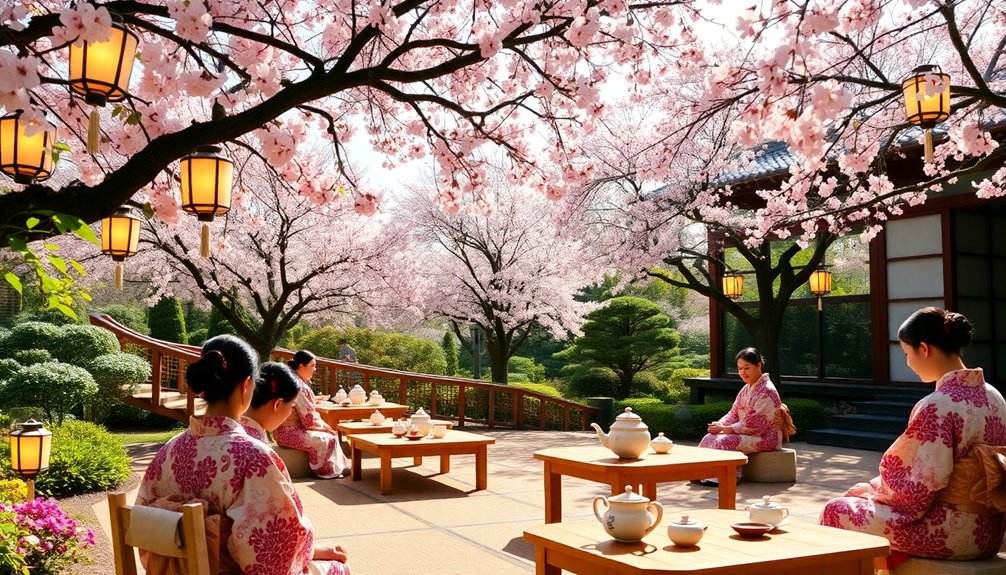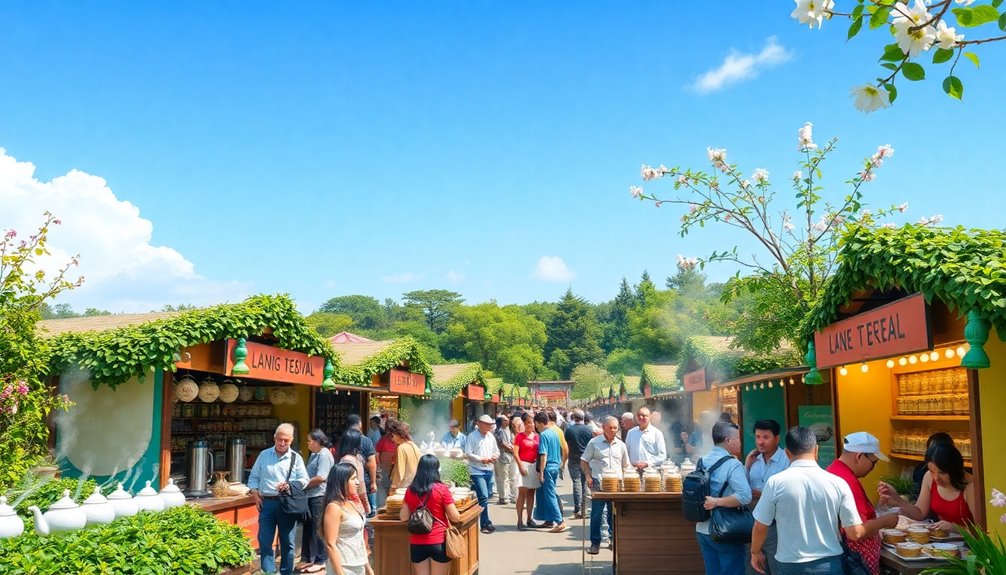At a traditional Japanese tea ceremony festival, you'll step into a world of beauty and culture. You'll see skilled tea masters prepare matcha, a special powdered green tea, with careful movements. Everyone wears elegant kimonos, adding to the festival's charm. You'll also enjoy delicious seasonal sweets and learn about the importance of harmony and respect during the ceremony. Each gathering is unique, reminding you to cherish every moment. Plus, you'll experience different flavors depending on the season! This celebration isn't just about tea; it's about connection and mindfulness. Stick around, and you'll discover even more interesting details!
Key Takeaways
- Experience the art of matcha preparation, showcasing the principles of harmony, respect, purity, and tranquility guided by trained tea masters.
- Attendees typically wear elegant kimonos, adding to the festival's cultural charm and authenticity.
- Participate in rituals such as purifying utensils and savoring seasonal sweets, enhancing mindfulness and appreciation.
- Enjoy seasonal variations of tea, like sakura-flavored matcha in spring or koicha in winter, connecting the experience to nature.
- Engage in moments of silence and reflection, embodying the "ichi go ichi e" principle that emphasizes the uniqueness of each gathering.
Introduction
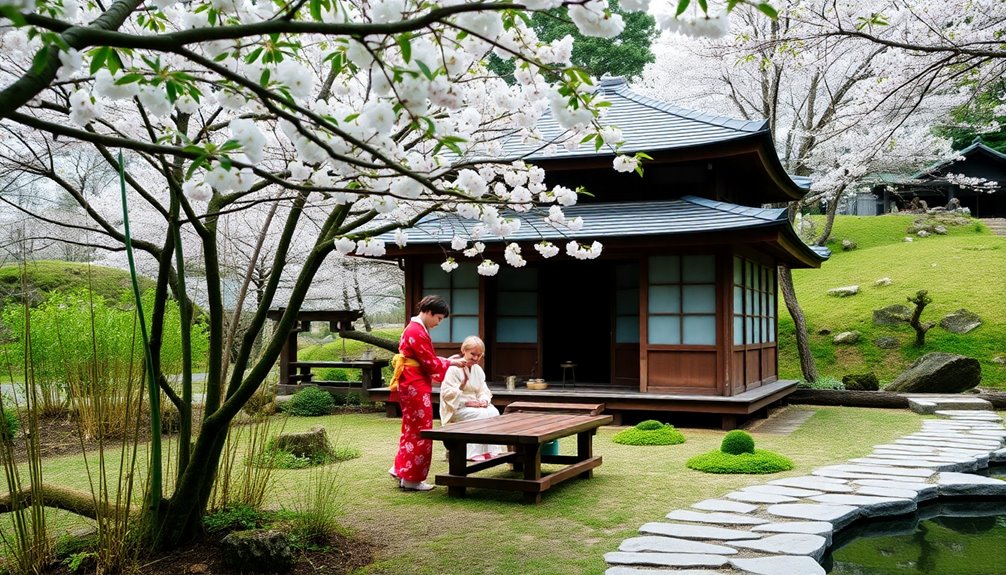
The traditional Japanese tea ceremony festival offers a captivating glimpse into the rich cultural heritage of Japan. You'll discover the beauty of the tea ceremony, where the preparation of matcha powdered green tea is an art form. Trained tea masters guide you through this serene experience, highlighting the core values of harmony, respect, purity, and tranquility.
As you walk in, you might notice attendees dressed in elegant kimonos, adding to the festival's charm. You'll participate in rituals, like purifying the utensils used for the ceremony and enjoying seasonal sweets before sipping tea. Each step is a mindful act, encouraging you to appreciate the moment fully.
The festival showcases various tea schools, such as Urasenke and Omotesenke, each with its own unique techniques and philosophies. You'll have the chance to learn about the history and etiquette of the tea ceremony through workshops and demonstrations.
These experiences deepen your understanding of Japanese culture and the significance behind each gesture. So come, immerse yourself in this delightful celebration, and enjoy the peaceful atmosphere created by the art of tea!
Cultural Significance of Tea

Embracing the art of tea in Japan reveals its profound cultural significance, rooted in centuries of tradition. The traditional Japanese tea ceremony, known as chanoyu, isn't just about drinking tea; it's a beautiful expression of harmony, respect, purity, and tranquility.
Each moment spent preparing and serving matcha, the powdered green tea, becomes an art form that encourages mindfulness and appreciation of the present.
In the tea ceremony, every detail matters. The tea utensils are carefully chosen, and the process reflects the deep connection between host and guests. This connection is highlighted by the concept of "ichi go ichi e," meaning "one time, one meeting." It reminds everyone that each gathering is unique and special.
Originally influenced by Zen Buddhism, the ceremony has blossomed into a symbol of Japanese culture. It blends spirituality with art, turning a simple act into a meaningful ritual.
As you participate, you'll feel the joy and peace that comes from engaging in this traditional practice. The tea ceremony isn't just about tea; it's about celebrating life and the bonds we share with one another.
Ceremony Emphasizes Mindfulness and Presence
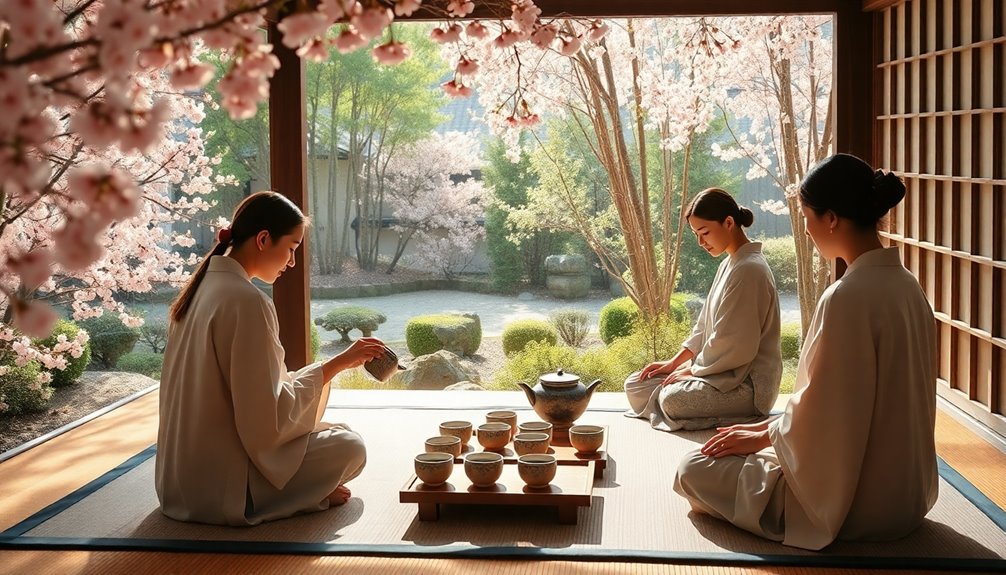
Mindfulness and presence are at the heart of the traditional Japanese tea ceremony, where each action is infused with intention and respect.
During this beautiful ceremony, you'll discover the principle of "ichi go ichi e," which means "one time, one meeting." This idea reminds us to cherish every moment shared with others.
As you witness the preparation of matcha, you'll notice how each movement is deliberate. The host shows great care for both the tea and the guests.
The tea room, with its seasonal decorations, creates a welcoming atmosphere that brings everyone together in harmony.
Throughout the ceremony, silence encourages you to reflect and focus on the sensory experiences around you. You'll taste the smooth tea, hear the gentle sounds of preparation, and feel the tranquility in the air.
Each little detail invites you to let go of distractions and be fully present. This shared experience fosters a deep connection among participants, making the tea ceremony a joyful celebration of mindfulness.
You'll leave feeling refreshed and inspired, carrying the spirit of the ceremony with you long after it ends!
Seasonal Tea Variations Offered
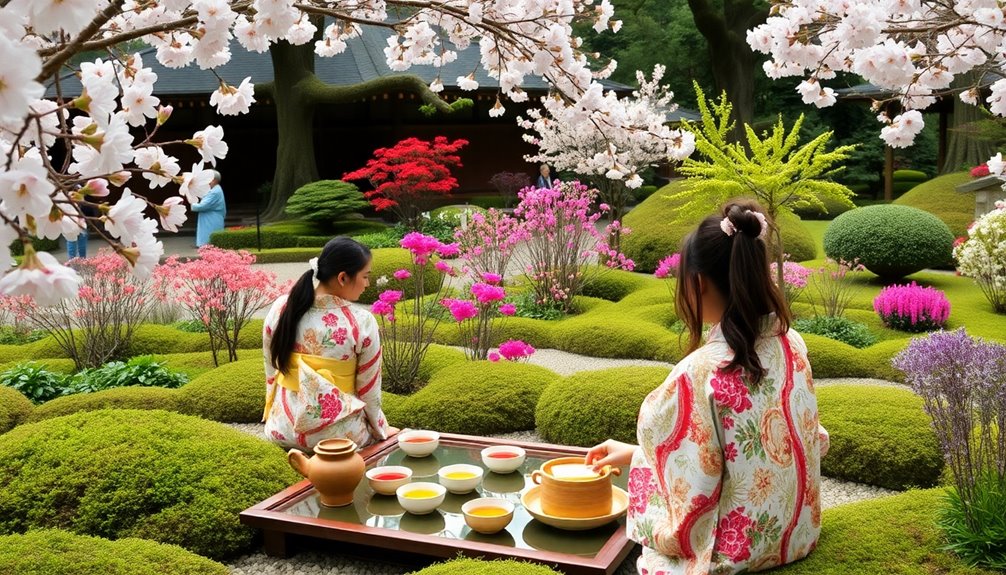
During a traditional Japanese tea ceremony festival, you'll find that seasonal tea variations play a crucial role in enhancing the experience. Each season brings its own unique flavors and delights.
In spring, you might enjoy sakura (cherry blossom) flavored matcha, which captures the beauty of blooming seasonal flowers.
As the leaves change in autumn, the ceremony is held with teas that feature roasted chestnut and sweet potato, celebrating the harvest. The warm colors of the foliage make these flavors even more special.
When winter arrives, you'll savor koicha, or thick tea, prepared to warm you up. This comforting tea is often paired with seasonal sweets that enhance its rich taste.
In the summer, refreshing iced matcha or lighter usucha (thin tea) is served, offering a cool treat for those hot days. Each seasonal variation emphasizes not just the flavors but also the beautiful presentation of the tea and accompanying sweets.
Participating in these seasonal tea variations during the festival makes tea drinking a joyful and memorable experience, connecting you to the rhythm of nature and the beauty of the traditional tea ceremony.
Cultural Appropriation Debates
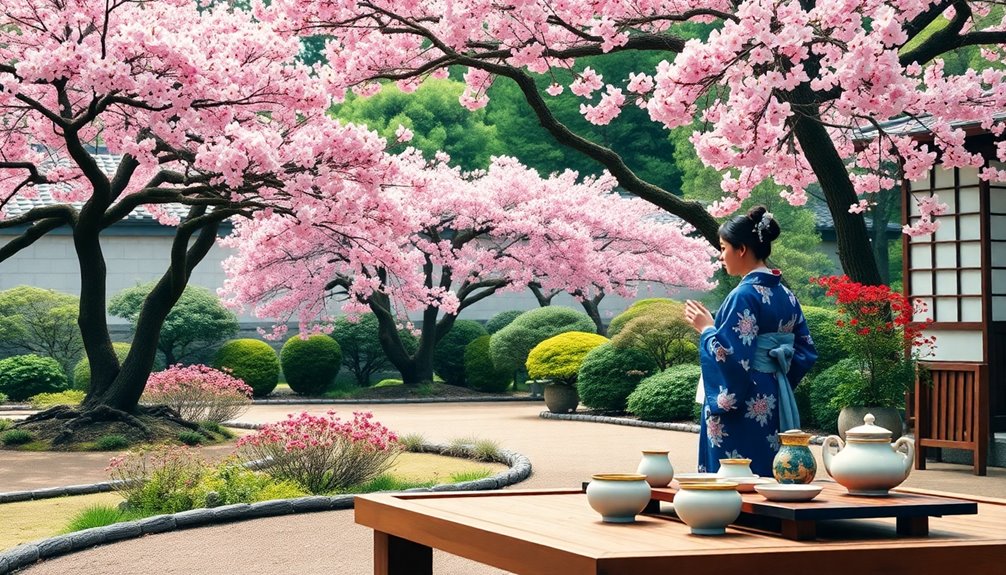
As you explore the rich traditions of the Japanese tea ceremony, discussions around cultural appropriation become increasingly relevant. It's important to engage with these traditional practices respectfully. Critics often argue that if non-Japanese people adopt tea ceremony rituals without understanding their historical context, it can weaken the authenticity and sacredness of the tradition.
However, supporters of cross-cultural exchange believe sharing the tea ceremony fosters appreciation and understanding of Japanese culture. They emphasize that it must be done thoughtfully and with respect for the values behind the ceremony. The concept of "omotenashi," or hospitality, highlights this idea, reminding everyone to honor the spirit of the tea ceremony.
To ensure participants truly grasp what the tea ceremony represents, many tea ceremony schools advocate for educational programs. These programs help teach about the ceremony's values and rituals, allowing everyone to enjoy its beauty while respecting its roots.
Practical Applications
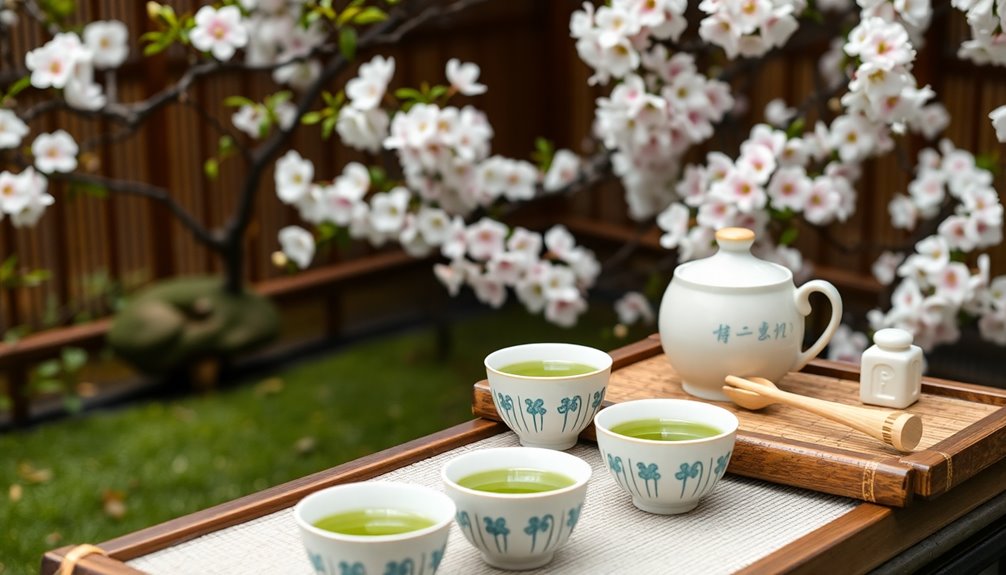
Experience the beauty of the traditional Japanese tea ceremony firsthand at festivals that bring this ancient practice to life. You'll find live demonstrations of the tea-making process, showcasing how tea masters prepare matcha with special tools like the chawan and chasen. It's fascinating to see the precision and artistry involved!
At these festivals, you can join in and learn hands-on. You might practice the etiquette and techniques of the tea ceremony, guided by experts from schools of tea like Urasenke or Omotesenke.
Imagine drinking tea and enjoying traditional Japanese sweets in serene locations, such as historic tea houses or beautiful gardens. It's the perfect way to feel the tranquility that's essential to the ceremony.
You'll also find educational workshops and talks about the history, philosophy, and significance of the tea ceremony. Discover the principles of harmony, respect, purity, and tranquility that shape this practice.
Each part of the festival helps deepen your understanding and appreciation for this beautiful tradition. So, come ready to learn, taste, and enjoy! You won't just watch; you'll be part of something truly special.
Frequently Asked Questions
What Not to Do at a Japanese Tea Ceremony?
At a Japanese tea ceremony, don't wear strong fragrances or flashy clothes. Avoid using your phone, excessive talking, or rushing. Respect the host by not touching utensils unless invited, and savor every moment intentionally.
What Are 5 Steps in a Japanese Tea Ceremony?
In a Japanese tea ceremony, you'll experience five main steps: welcoming guests, enjoying a kaiseki meal, preparing matcha with care, serving the tea, and concluding with gratitude and reflection on the experience.
What Do You Wear to a Japanese Tea Ceremony?
When attending a Japanese tea ceremony, wear modest clothing, preferably a kimono. Avoid strong fragrances and bright colors. Ensure your outfit's suitable for low entryways, reflecting respect for the ceremony's ambiance and seasonal themes.
What Are the 4 Principles of Japanese Tea Ceremony?
The four principles of the Japanese tea ceremony are harmony, respect, purity, and tranquility. You'll experience a deep connection with others, appreciate the beauty around you, and cultivate a peaceful mindset throughout the ceremony.
Conclusion
Attending a traditional Japanese tea ceremony festival is an exciting way to dive into a beautiful culture! You'll experience the joy of sipping tea, enjoying tasty treats, and learning about the art of mindfulness. Each ceremony is special, with different flavors and styles reflecting the seasons. Remember, it's important to appreciate and respect these traditions. So, grab a friend and get ready to make some wonderful memories at the festival! You won't want to miss it!

